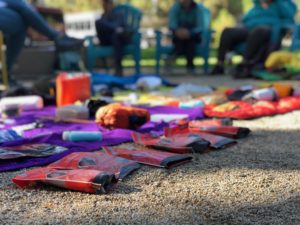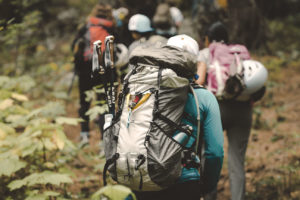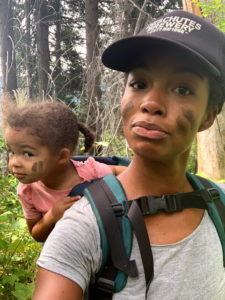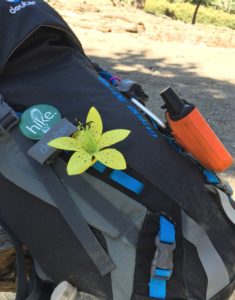DAY HIKING 101: AN INTRODUCTION TO HIKING
So you want to go hiking? Awesome! We are stoked that you want to go hiking and want you to LOVE it as much as we do.

Posted on Thu 28 May 2020 · by Saveria Tilden
So you want to go hiking? Awesome! We are stoked that you want to go hiking and want you to LOVE it as much as we do. Let’s talk about Day Hiking 101! We hope this blog post answers some questions you may have, provides some helpful tips, and inspires you to get outside.
what is hiking?
We are defining a day hike as one that does not include an overnight. Hiking can mean different things to different people which is what makes hiking so awesome. Hiking can be a simple walk in a local park, a long day on the mountains, even an urban trek through a city.
what is hiking to you?
People choose to hike for many reasons… exercise, recreation, alone time, social time, family time. Day hikes can be one hour or many hours, they can be close to home nearby nature experience or an adventure to a more remote destination. Hiking can be part of your daily routine or a planned adventure. Hiking can be any of these things. If you are just starting out the fun part is discovering what hiking will be for you.
There are two important steps to consider when heading out for a hike…
1) having a plan
2) being prepared
We know this may sound obvious, but many people don’t spend enough time on these steps before hitting the trails. Therefore we are going to give you some tips and resources to help in planning a fun and safe adventure.
STARTING WITH A PLAN

where should you go?
There are lots of ways to decide where to go hiking. Trail websites and guide books are great resources to discover trails. Joining hiking communities with like-minded folks. Going out with people that you don’t know can be a great way to discover trails and meet new people. For bigger technical goals or when traveling to far-away places consider hiring a professional guide service. Part of a good plan is knowing what you are getting into.
doing your homework!
The best way to have fun on your hike is to know what you are getting into, so do your homework – especially on bigger hikes. Some questions you should ask before hitting the trail – is the trail open, how long is the hike, what is the elevation gain and loss, how long do you plan to be out, what is the parking availability, are there parking or entrance fees, do you have a map, what are the COVID-19 regulations. Use this information to create a plan for the day and most importantly be sure to share your plan with someone in case things don’t go as plan.
don’t underestimate the human factor.
Know yourself and be realistic about what you are prepared for. Know your companions – be sure that you are all on the same page for the hike. Hike with people who have compatible fitness levels so no one feels pressured to keep up or gets left behind. When hiking with kids, have realistic expectations – the hike will probably be shorter, choose appropriate trails – flat wide trails may allow for more hiking and less carrying of the kiddos, and bring snacks… lots and lots of snacks.
hiking with kids!
We were asked how to pick good hikes for kids. Chelsea Murphy, @She_ColorsNature, shares that most places are going to have kid friendly hikes. Alltrails is a great resource for finding trails. Any hike within the less than 500 elevation gain and between 4-6 miles is decent for beginners. Some hikes may even be labeled kid friendly!
BE PREPARED

a little knowledge will go a long way.
As you start to plan bigger and more ambitious hikes there are skills that could prove very useful in making sure you stay safe – navigation with a map and compass, Wilderness First Aid, and trip planning. REI Outdoor School is a great place to start
what you should have in your pack for every hike.
Know the 10 Essentials for Hiking and have them with you on EVERY hike.
- Appropriate Footwear
- Map & Compass/GPS
- Water
- Food
- Rain Gear & Layers
- Safety Items (light, whistle, fire starter)
- First Aid Kit
- Knife or Multi-Tool
- Sun Protection
- Shelter
Many of these items may seem unnecessary but are on the list to help keep you safe in case something unplanned happens.
sharing the trail!
Be prepared to share the trail and be respectful of the land and other hikers. Take a moment to review proper hiker etiquette and learn about the Seven Principles of Leave No Trace. Please educate yourself and follow your local COVID-19 protocols. Doing these things will ensure the trails stay open and enjoyable for all.
TIME TO GEAR UP!

what gear do you really need to head out the door?
- Footwear – Any shoe or boot with good traction. Your choice should depend on what hike you are doing and the terrain you will encounter.
- Clothes – Synthetic materials are preferred due to their ability to dry quickly and wick moisture away from your body. Dressing in layers helps manage your temperature and keep you from getting too hot or too cold.
- Day pack (20-30 liter) – You want to make sure that your backpack fits you well and can comfortably hold your 10 essentials, water, snacks, and clothing layers.
- Water – Be sure to bring enough water with you. If you are hiking someplace with access to water you can bring a filter to refill your water. For hot strenuous hikes having an electrolyte drink in addition to your water can be a good idea.
Using a checklist is a great way to help prep for a hike and make sure you don’t forget important items.
WHAT’S IN OUR PACKS

On a recent Hiking 101 webinar Chelsea Murphy, @She_ColorsNature, and Saveria Tilden, AdventurUs Women Founder, did a pack shakedown of what is in their packs when they go for a day-hike! Chelsea shared what goes into her pack when hiking with her kids and Saveria shared what she brings on a day hike in the mountains. Curious? To find out what was in their packs, click here.
